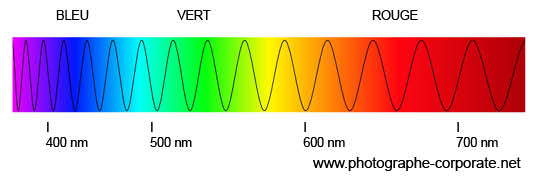The light
Photography, a word that has its origin in the ancient Greek
Photo = Photon which means light; Graphie = to write, to draw
Light is a set of electro-magnetic waves to which our human eyes are sensitive. A wave is characterized by its wavelength.
A human eye is sensitive to waves between 400 and 700 nanometers. 1 nanometer (nm) = 10 -9 m = 0.000000001 meter
In this range of 400 to 700 nm, each wavelength corresponds to a different visual sensation, so 1 color.
In this visible spectrum, there are 3 main colored areas:

These 3 colors BLUE / GREEN / RED are the fundamental primary colors
They are the basis of human vision and photo systems.
Indeed, on the human retina, there are cones sensitive to colors.
1/3 of these cones are sensitive to BLUE
1/3 of these cones are sensitive to GREEN
1/3 of these cones are sensitive to RED
In a color silver film, which has 3 layers, there is a layer sensitive to BLUE, a layer sensitive to GREEN and a layer sensitive to RED.
In a digital sensor, some of the photosites are sensitive to BLUE, some of the photosites are sensitive to GREEN and some of the photosites are sensitive to RED.
The association of these 3 primary colors allows to recreate ALL THE OTHER COLORS
The whole of the visible radiations simultaneously creates the WHITE LIGHT
White = Blue + Green + Red;(in equal proportion)
White = 1/3 Blue + 1/3 Green + 1/3 Red
If one of these thirds is a little more important, it changes the whiteness of this light, and therefore its color temperature (CT)
And this has a direct impact on the BALANCE OF WHITES
BLACK = NO RADIATION VISIBLE BETWEEN 400 and 700 nm
The colors
3 fundamental primary colors = B G R (Blue Green Red) or in English RGB = Red Green Blue
When we associate 2 primary colors, then we obtain a SECONDARY COLOR which is the COMPLEMENTARY of the absent primary.
BLUE + GREEN = CYAN; cyan is the complementary of red
Note: The complementary is the most different color, opposite of the primary color concerned.
GREEN + RED = YELLOW; which is the complementary of blue
BLUE + RED = MAGENTA; which is the complementary of green.
2 colors are complementary when their association gives the neutral, ie WHITE / BLACK / GREY
Ex : [B+R= MAGENTA] + V ==> B + R + V = WHITE
==> 3 fundamental secondary colors : YELLOW – MAGENTA – CYAN
It is with these 3 dyes, and only with these 3 that we obtain the prints or color prints.
Color temperature
It is known that a white light is composed of 1/3 of Blue, 1/3 of Green and 1/3 of Red
In general, all white light sources do not scrupulously respect these proportions
BLUE
- Natural light is rich in blue
- The flashes are rich in blue light
- LEDs and fluorescent tubes are rich in blue
RED
- All TUNGSTENES are rich in red
All these light sources have a color temperature expressed in KELVINS K° (measured with a thermo colorimeter)
Color Temperature (CT)
The HIGHER the CT, the more blue the light source (COLD LIGHT)
The LOWER the CT, the more red the light source (HOT LIGHT)
CT Benchmarks
5500 K° ==> Natural daylight and electronic flash
6000 K° ==> Fluorescent, Led
3200 K° ==> Tungsten, halogen, Quartz
In silver color photography, we have the same problems of color temperature.
We have 2 ranges of films:
- A balanced range for 5500 k° (Type D film)
- A balanced range for 3200 k° (T-type film)
Article written by Vincent Kem, as a corporate photographer